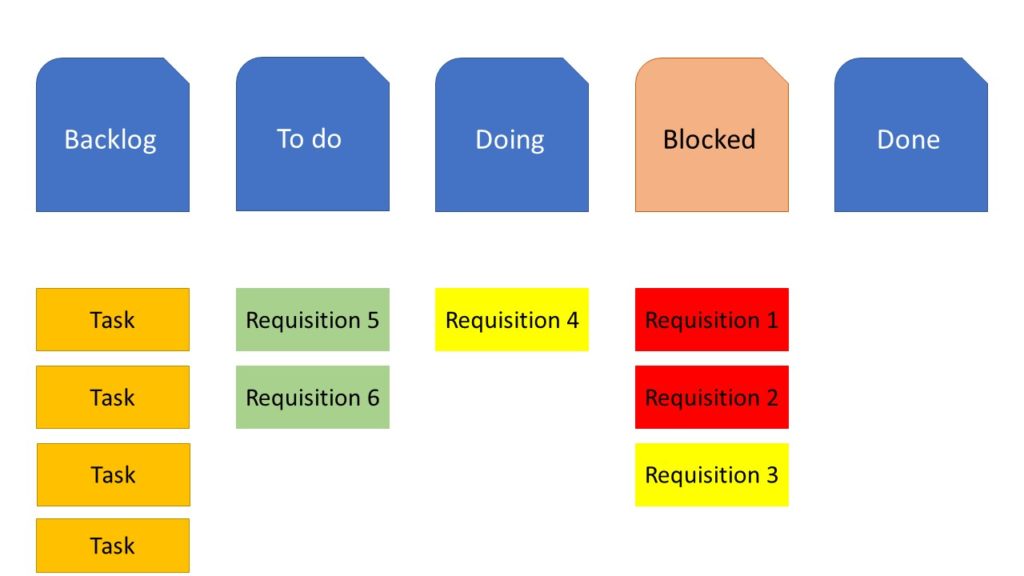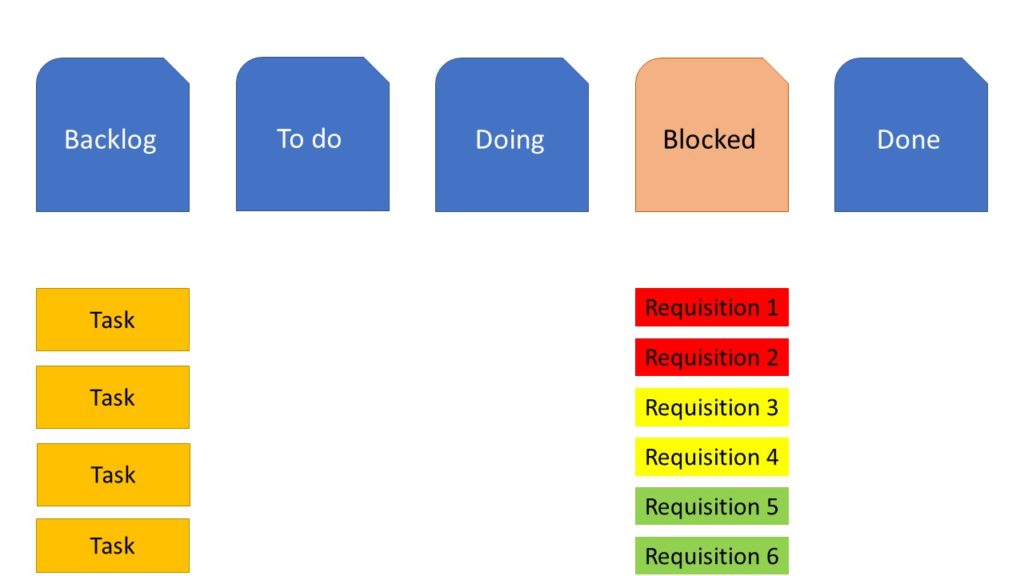The end of the fiscal year was upon us. With only a week left before the funds for the year were swept, we were in a mad dash to get those last few requisitions through the approval process. As each day came to a close, requisitions began to back up in the approval process. With each passing day the window for the fiscal year funds got smaller. Repeated requests and inquires just didn’t budge the flow of requisitions. In short – we had a bottleneck on our hands. What we discovered due to our use of a Kanban board was our business partner had several bottlenecks in their own team that was slowing us down.
Over the last few weeks, we’ve talked about the IT secret method to get more things done more efficiently. I call it a secret because if you aren’t in IT, agile is probably a foreign word.
Last week, we discussed one tool that comes from agile – the Kanban board. It’s an expansion of the usual to do list from a list of tasks that are marked off as complete. One benefit of the Kanban board is that it helps set transparent priorities for the team that illustrates which tasks are actively being worked on – and where the task is in the workflow.
Another use for the Kanban board is to help identify continuous process improvement opportunities by visualizing workflows and identifying blockages in that flow.
The Theory of Constraints versus a Bottleneck
In 1984, E. Goldratt wrote about the theory of constraints. In short, theory aimed to explain the rate of goal achievement by a goal-oriented system. Goldratt explained that the speed work could be accomplished was negatively impacted by one of three constraints.
These constraints include:
- Equipment
- People
- Process/policy
As an important clarification, a constraint is a long-term restriction in the speed of getting things accomplished. A bottleneck, conversely, is a short-term restriction in the speed with which work is accomplished.
In the government, as an example, the policies and procedures from OPM for hiring are a constraint. Conversely, a hiring freeze is a bottleneck because it is a short term policy that limits the amount of hiring that can be done. If and when the hiring freeze is lifted, the constraint of the OPM policies and procedures for hiring will still limit the pace of hiring.
That being said, I believe that bottlenecks could easily be organized into the same categories of constraints.
Kanban boards and blockages
On adaptation of a simple Kanban board is to include a column for blocked tasks. The most obvious benefit of having a column for blocked tasks is to allow the team member working on the task to move on to an un-blocked task.
Recall, that in a true agile environment a team member (or team) is only working on a single task at a time. This task is placed in the Doing column. And, until that task moves to the Done column, that’s the only task the team member is to work on. Also, that the tasks should only require a maximum of one business day. If the task takes more than one business day then the task is too large to be placed onto the Kanban board and needs to be further broken down. However, a blocked task may appear as though it takes longer than one day.
Identifying the bottlenecks
Let’s return to the story we started with about the requisitions being blocked by a bottleneck in the approval process.
Day 1
At the start of a new business day, my team and I reviews the current work. Using the Kanban board, it becomes glaringly obvious that a bottleneck is at play. As the leader of the team (aka, the Scrum Master) it’s my responsibility to understand and remove blockages.
We discuss what’s going on. What exactly is the blockage? What has the team done so far to remove the blockage?
Now the beauty of the Kanban board is that if I’d stopped by their office any time during the day, I could easily see something was going awry. I didn’t actually have to wait until the following morning for our daily check in. Also, I can easily get a sense of just how bad the bottleneck is – is it just one blocked task?
In this case, it’s already 3 blocked requisitions in a single day with 3 more already in the pipeline. If nothing is done, we will likely have 6 requisitions blocked by the end of this business day.
In my initial investigation, I discovered that our business partner had a single person who could sign our requisitions. That person was out on leave the prior day and had caused the 3 requisitions to be blocked for the prior business day. This meant it was a people bottleneck.
I was assured that the requisitions would proceed today.
Day 2
So, the next morning, my team and I reviewed our Kanban board. And, our worst concerns were now playing out. Not only did we have 6 requisitions blocked, we had a stop-work in our own team because all of our planned work was now unable to proceed.
With frustration that my initial efforts to understand and remove the blockage for my team, I followed up with our business partner again. I discovered that the single person had returned, but had not actually signed off on the requisitions. In questioning the person, I found that there was a second person who could sign requisitions in her absence. And, that since she had lost her signing authority weeks earlier, had delegated the task to Person 2 to sign.
I asked Person 2 if she could sign the requisitions for us to remove the blockage. She referred me back to Person 1 since she had lost her signing authority weeks earlier – and because it wasn’t really her job – it was Person 1’s job. Several emails and hours later – escalating the issue to the business partner’s management – the requisitions were signed.
In short, the people bottleneck had expanded and now included a process bottleneck. Although the business partner had apparently built in some redundancy into their process to prevent a people bottleneck – the process had broken down due to each person not maintaining their signing authority.
Continuous improvement using the Kanban board
As you can see from this example, there was a number of ways the Kanban board helped identify the problems and work towards a resolution.
- The problem (blocked requisitions) is identified early.
- The size of the problem is easily measured.
- Compounding impact of the bottleneck is observable.
- The team has a way to communicate that incomplete work is out of their control.
- Data can be used to demonstrate to business partners the existence and impact of the bottleneck.
What I loved about this approach is that it prevented us from solving the symptoms.
Under normal circumstances, we likely would have seen the slowdown in requisition processing and assumed it was an issue with our own team. We might have added people to the team. We might have put performance improvement plans in place. Or, we might have sent our team to training with the assumption that they just didn’t know how to process the requisitions.
Instead, we were able to use the Kanban board as an early warning system – and as a communication tool. It allowed us to identify and target exactly where our bottleneck existed and how to plan ahead to try to account for these kinds of slowdowns in the future.
Take action!
I challenge you to try out the Kanban board to identify bottlenecks in one of your own team’s tasks. Let us know how it goes!
Use a different tool to identify bottlenecks? Tell us about them in the comments below.
Most of the time, I like using stickynotes to work through our Kanban board. But, it assumes that the whole team is co-located. If you prefer a more electronic method or have a team that is physically distributed, there is a number of tools available. My personal favorite, however, is Trello.





